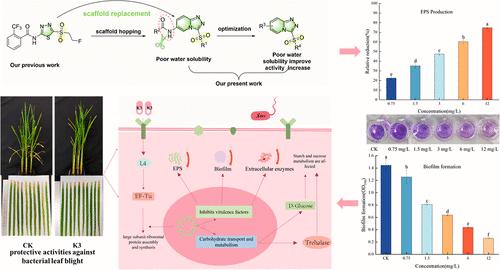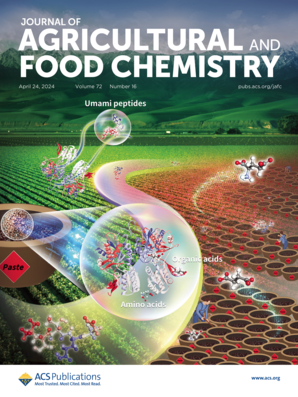Design, Synthesis, and Antibacterial Activity of Novel Sulfone Derivatives Containing a 1,2,4-Triazolo[4,3-a]Pyridine Moiety
IF 5.7
1区 农林科学
Q1 AGRICULTURE, MULTIDISCIPLINARY
引用次数: 0
Abstract
To develop antibacterial agents with a novel mechanism of action, a series of sulfone compounds containing a 1,2,4-triazolo[4,3-a]pyridine were designed and synthesized by progressive molecular structure optimization. The antibacterial activities of some derivatives against the four plant pathogens Xanthomonas oryzae pv. oryzae (Xoo), Xanthomonas oryzae pv. oryzicola (Xoc), Xanthomonas axonopodis pv. citri (Xac), and Pseudomonas syringae pv. actinidiae (Psa) were evaluated. Among them, compound K3 demonstrated significant antibacterial activities against Xoo, Xoc, and Xac, with EC50 values of 1.5, 1.7, and 4.9 mg/L, respectively. In the greenhouse, compound K3 exhibited a protective activity of 44.49% and a curative activity of 42.51% against rice bacterial leaf blight, which notably surpassed the traditional agents thiodiazole-copper (24.65% and 23.35%) and bismerthiazol (34.69% and 30.78%). Furthermore, compound K3 can inhibit the growth of pathogenic bacteria by inhibiting a variety of virulence factors (extracellular polysaccharides, biofilms, and motile and extracellular enzymes.). It also induced the production of reactive oxygen species (ROS) by the pathogens, leading to their death. Transcriptomic analysis revealed that K3 impacts rice biosynthesis, biofilm formation, and metabolic processes, enhancing the plant’s self-defense biochemical processes and affecting carbohydrate transport and metabolism to resist pathogen invasion. Therefore, the inhibition of virulence factors as a strategy for controlling difficult-to-treat plant bacterial diseases presents a promising approach to the discovery of novel antibacterial candidates.

含有1,2,4-三唑[4,3-a]吡啶的新型砜衍生物的设计、合成和抗菌活性研究
为了开发具有新型作用机理的抗菌药物,采用分子结构优化的方法,设计合成了一系列含有1,2,4-三唑[4,3-a]吡啶的砜类化合物。部分衍生物对四种植物病原菌米黄单胞菌的抑菌活性。oryzae (Xoo), Xanthomonas oryzae pv。稻瘟病菌(Xoc),黄单胞菌(Xanthomonas axonopodis pv)。丁香假单胞菌;对actitindiae (Psa)进行了评价。其中,化合物K3对Xoo、Xoc和Xac具有显著的抑菌活性,EC50值分别为1.5、1.7和4.9 mg/L。在温室中,化合物K3对水稻白叶枯病的保护活性为44.49%,治疗活性为42.51%,显著优于传统药剂硫代二唑铜(24.65%和23.35%)和双硫代噻唑(34.69%和30.78%)。此外,化合物K3可以通过抑制多种毒力因子(胞外多糖、生物膜、运动酶和胞外酶)来抑制致病菌的生长。它还诱导病原体产生活性氧(ROS),导致其死亡。转录组学分析表明,K3影响水稻的生物合成、生物膜形成和代谢过程,增强植物的自卫生化过程,影响碳水化合物的运输和代谢,以抵抗病原体的入侵。因此,抑制毒力因子作为一种控制难治性植物细菌性疾病的策略,为发现新的候选抗菌药物提供了一条有希望的途径。
本文章由计算机程序翻译,如有差异,请以英文原文为准。
求助全文
约1分钟内获得全文
求助全文
来源期刊
CiteScore
9.90
自引率
8.20%
发文量
1375
审稿时长
2.3 months
期刊介绍:
The Journal of Agricultural and Food Chemistry publishes high-quality, cutting edge original research representing complete studies and research advances dealing with the chemistry and biochemistry of agriculture and food. The Journal also encourages papers with chemistry and/or biochemistry as a major component combined with biological/sensory/nutritional/toxicological evaluation related to agriculture and/or food.

 求助内容:
求助内容: 应助结果提醒方式:
应助结果提醒方式:


